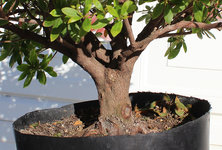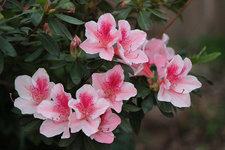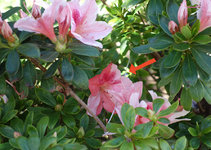I found this azalea (Southern Indica) a few years ago. It has amazing nebari, a good single trunk, and clearly wants to be some sort of broom style. I gave it an initial chop after purchase to start bringing energy back into the interior, but I know it needs a much harder chop to start building ramified branches and pads. I've just been hesitant to do it (wrong), because I understand Azaleas heal very slowly, if at all.
The main hangup I'm having is with the branches on the left side. Two of them are massive and throw off the visual balance of the tree when viewed from the best front. The rear branch makes up almost a quarter of the trunk. The front branch has a three-way junction that will swell over time, so I either need to remove it, or one of the smaller, more desirable branches. Anywhere I hack them off, it's going to leave a massive scars, so I want to make the best choice.
Should I take the rear one off all the way down at the base, and try to grow a new branch there? Should I leave an inch or two and grow from there? I know the pictures don't provide a lot of info. I'd have to defoliate it to really show the branch structure, and I don't want to do that before I chop it. But if better pictures are needed, I could post more during the chop process, and remove material over a few days. It's just starting to bloom, so I plan to chop it in two or three weeks when it's done.
The main hangup I'm having is with the branches on the left side. Two of them are massive and throw off the visual balance of the tree when viewed from the best front. The rear branch makes up almost a quarter of the trunk. The front branch has a three-way junction that will swell over time, so I either need to remove it, or one of the smaller, more desirable branches. Anywhere I hack them off, it's going to leave a massive scars, so I want to make the best choice.
Should I take the rear one off all the way down at the base, and try to grow a new branch there? Should I leave an inch or two and grow from there? I know the pictures don't provide a lot of info. I'd have to defoliate it to really show the branch structure, and I don't want to do that before I chop it. But if better pictures are needed, I could post more during the chop process, and remove material over a few days. It's just starting to bloom, so I plan to chop it in two or three weeks when it's done.






